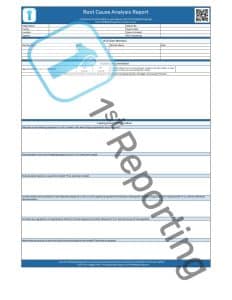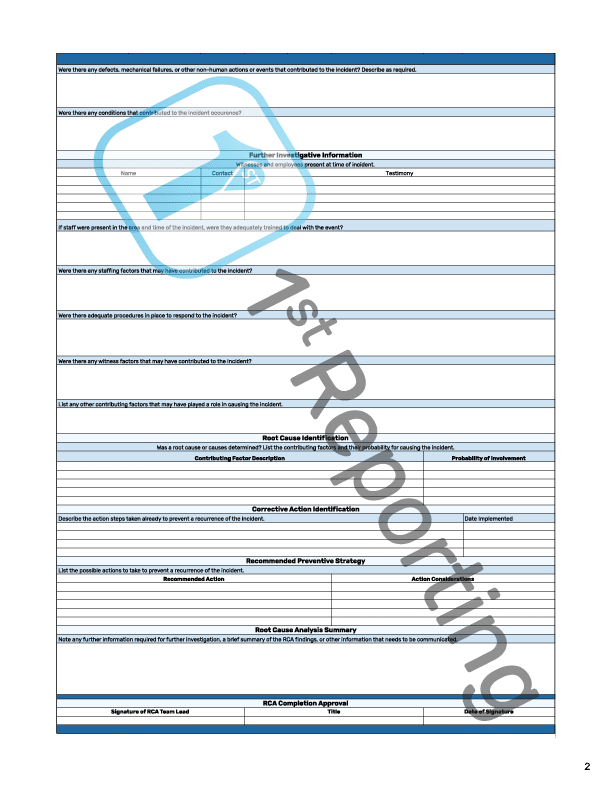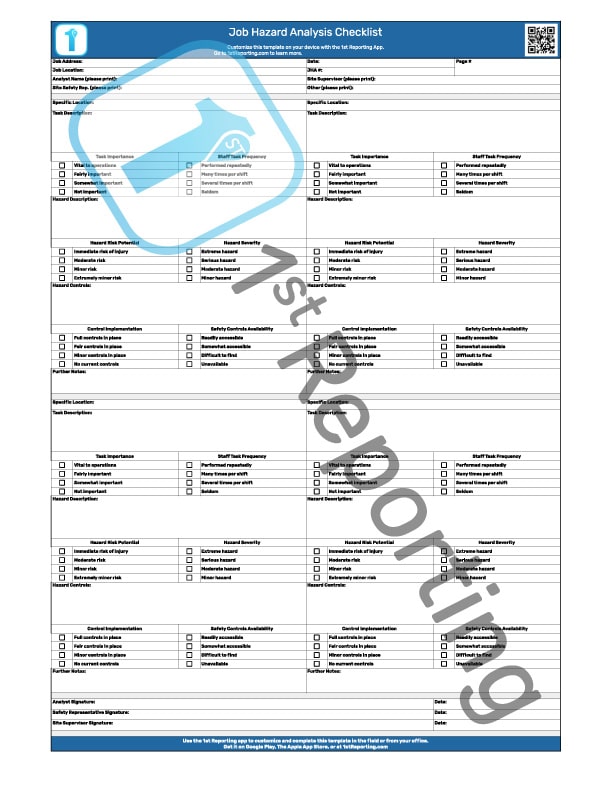Updated September 15, 2024.

We have all faced one situation or another at work where someone or thing was injured (or nearly injured). When incidents arise, we often rise to the challenge and help those in need. However, reactive management is only half the battle when it comes to incidents. We need to perform a root cause analysis to determine the real causes of the incident.
What is a Root Cause Analysis?
A root cause analysis is the investigation process following an incident to determine why an incident occurred.
Like the downloadable root cause analysis template, a standardized template will help organize your RCA efforts.
Every business and organization must prepare for incidents. Therefore, a predefined plan for incident reporting and root cause analysis is vital to your operations.
Employers covered by OSHA’s Process Safety Management (PSM) standard must determine the root cause or potential cause for catastrophic incidents. Even if the PSM doesn’t cover your business, working through a root analysis action plan is still more than wise to prevent incidents.
Out of this need for a defined root cause analysis action plan, we’ve created a digital and downloadable PDF version of a standard RCA template for you (keep reading to get to the download point).
This article will cover what’s included in the template, the primary use of the RCA template benefits to its use, some RCA tips, and lastly, an even better solution for your RCA processes than a downloadable one.
Included In The Root Cause Analysis Template
Don’t want a double-page downloadable form?
The root cause analysis template consists of three pages. The document breaks down into seven primary sections:
- Administrative Area
- Incident Documentation
- Leading Event Determination
- Further Investigative Information
- Root Cause Identification
- Corrective Action Identification
- Recommended Preventive Strategy
- Root Cause Analysis Summary
All elements of the RCA template are critical to a successful analysis. The template areas are relatively simple to comprehend and rooted in a common-sense reporting strategy. In the following section, we’ll explore each template area more in-depth and detail how to use it effectively.
RCA Methodologies
Completing a root cause analysis (RCA) successfully requires a standard methodology that can be used repeatedly. Let’s examine a few common methods.
The Fishbone Model RCA

A fishbone diagram (also called an Ishikawa diagram, sometimes referred to as a cause-and-effect diagram) is a visual tool used in Root Cause Analysis (RCA) to identify the potential causes of a problem. It helps teams systematically explore all possible factors that could contribute to an issue, organizing them in a way that shows the relationships between these factors and the effect (the problem). This method is particularly effective when you want to uncover multiple layers of causes for a specific problem.
Structure of a Fishbone Diagram:
- The diagram is shaped like a fish’s skeleton, with the “head” representing the problem or effect.
- The “bones” extending from the spine represent the categories of potential causes.
- Each category can branch out further into more specific causes.
Steps to Create a Fishbone Diagram for RCA:
- Identify the Problem or Issue: Start by clearly defining the problem or the effect you are trying to analyze. It is written at the “head” of the fish.
- Identify the Main Categories of Causes: These are broad categories that could contribute to the problem. Common categories include:
- People: Human-related causes such as training, motivation, or communication.
- Methods: Processes or procedures that might be ineffective or unclear.
- Materials: Issues related to the resources being used, like raw materials or equipment.
- Machines: Equipment or technology that could be malfunctioning.
- Measurements: Inaccuracies in data or performance indicators.
- Environment: External factors such as weather, regulations, or work conditions. Depending on your industry or the problem you’re analyzing, you might modify these categories (for example, software teams may use categories like “software,” “hardware,” and “testing”).
- Brainstorm Potential Causes: For each category, brainstorm specific potential causes. For example, under “People,” you could identify “lack of training” or “communication breakdown.” These causes are added as branches extending from the main category.
- Dig Deeper: For each identified cause, ask, “Why is this happening?” and add more layers if necessary. It helps uncover root causes that aren’t immediately obvious.
- Analyze the Diagram: After filling out the diagram, review the causes and identify which ones are most likely contributing to the problem. The diagram allows you to see all potential causes visually and investigate them further.
Example of a Fishbone Diagram:
Suppose a company is facing frequent equipment failures. In the fishbone diagram:
- The effect (problem) is “equipment failure” at the head.
- Categories could include:
- People: Inadequate training, operator errors.
- Methods: Incorrect maintenance procedures and unclear operating guidelines.
- Materials: Use of faulty components and low-quality materials.
- Machines: Outdated machinery, lack of regular maintenance.
- Measurements: Lack of performance data inaccurate calibration.
- Environment: Dusty or humid work conditions, power fluctuations.
Each of these categories can branch out with more specific causes that relate to the problem.
Relative Use of Fishbone Diagrams in RCA:
Fishbone diagrams are particularly useful in RCA for several reasons:
- Structured Thinking: They organize thoughts systematically, ensuring that every possible cause is considered and grouped logically.
- Broad Application: They are flexible and can be applied to a wide range of industries and problems, from manufacturing defects to service delays.
- Visual Clarity: The diagram’s structure makes it easy to visualize complex cause-and-effect relationships, helping teams quickly identify root causes.
- Team Collaboration: Fishbone diagrams are highly effective when used in group brainstorming sessions. They allow different perspectives to contribute to uncovering causes.
- Focus on Root Causes: By focusing on categories and drilling down into each, fishbone diagrams help prevent jumping to conclusions based on symptoms. They encourage teams to dig deeper and find the true underlying causes of a problem rather than stopping at surface-level issues.
- When to Use a Fishbone Diagram:
- Complex Problems: Use it when a problem has many potential causes, and you need to explore them systematically.
- Team Investigations: They work well when multiple people from different departments need to collaborate and share their insights.
- Recurring Issues: Fishbone diagrams are ideal for identifying the root causes of problems that occur repeatedly.
The Pareto Analysis Method

The Pareto method, also known as Pareto analysis or the 80/20 rule, is a decision-making technique used to prioritize the most significant causes of a problem or the most critical factors in a process. It’s based on the principle that 80% of effects come from 20% of causes. This method is highly effective in Root Cause Analysis (RCA) for identifying and focusing efforts on the most impactful root causes of a problem.
Key Concepts of Pareto Analysis:
- The 80/20 Rule: The main idea behind the Pareto method is that a small number of causes (roughly 20%) are responsible for the majority (80%) of the problem’s effects. It is often applied to business problems, quality control, and defect analysis.
- Prioritization of Causes: Using the Pareto method, you can focus your efforts on addressing the causes that will have the most significant impact on solving the problem instead of spreading resources thinly across all causes.
Steps to Perform Pareto Analysis:
- Identify the Problem: Clearly define the problem or effect you’re trying to solve. It could be anything from equipment failures, customer complaints, defects in manufacturing, or delays in a process.
- List Potential Causes: Once the problem is identified, list all potential causes or contributing factors. For example, if you’re looking at customer complaints, the causes might include product defects, poor customer service, shipping delays, etc.
- Collect Data: Gather data on each cause to quantify its frequency or impact. You could look at how often a specific cause occurs or the severity of its effect. This data is typically collected over a specific time to get a good sense of trends.
- Sort Causes by Impact: Arrange the causes in descending order, starting with the cause that has the most significant impact or occurs most frequently. You may want to express these values as percentages of the total effect or problem.
- Create a Pareto Chart: This chart is the primary tool for visualizing the Pareto analysis. It is a type of bar graph where:
- The x-axis represents the causes.
- The y-axis shows the frequency or impact of each cause (usually as a percentage).
- The bars are arranged in descending order from left to right, starting with the most significant cause.
- Additionally, a cumulative percentage line is plotted, which helps identify the point where the top causes contribute the most to the problem.
- Identify the Vital Few Causes: Once the chart is created, look for the point at which roughly 80% of the problem is accounted for by 20% of the causes. These “vital few” are the causes you should focus on addressing.
Example of Pareto Analysis:
Let’s say you’re investigating why customers frequently return a product. After gathering data, you find the following causes:
- Product defects: 40%
- Late delivery: 25%
- Poor customer service: 15%
- Miscommunication on product features: 10%
- Packaging issues: 5%
- Other causes: 5%
When you plot these causes on a Pareto chart, you’ll likely find that product defects and late delivery are responsible for most of the returns (65% combined). Using the 80/20 rule, you can focus on resolving these two primary causes to address a significant portion of the problem.
Benefits of Using the Pareto Method:
- Focused Problem-Solving: Pareto analysis helps you identify where to focus your energy for the most significant improvement. Rather than attempting to fix every issue, you can zero in on the top causes that are responsible for the majority of the problem.
- Efficient Resource Allocation: By identifying the most impactful causes, you can allocate resources like time, money, and personnel to areas that will produce the highest return on investment.
- Data-Driven Decision Making: The method is based on accurate data, ensuring that decisions are made based on facts rather than assumptions or guesswork.
- Improves Process Efficiency: It helps streamline processes by eliminating or reducing the most frequent or severe issues, leading to higher efficiency, fewer defects, or better customer satisfaction.
- Clear Visualization: The Pareto chart offers a simple way to visualize problems, helping teams quickly understand where the focus should be.
Use Cases for Pareto Analysis:
- Quality Control: Identifying the few causes of the majority of product defects in manufacturing.
- Customer Service: Understanding why customers are dissatisfied and addressing the most common complaints.
- Project Management: Focusing on the tasks that will bring the most significant project progress or removing the biggest bottlenecks.
- Supply Chain Issues: Identifying the factors that cause the majority of delays or cost overruns.
Limitations of Pareto Analysis:
- Not Always 80/20: The 80/20 rule is a guideline, not an exact science. Sometimes, the distribution of causes may not follow the 80/20 pattern. Still, the principle of focusing on the most impactful causes remains valid.
- Doesn’t Provide Solutions: Pareto analysis helps prioritize problems but doesn’t offer solutions to the identified causes. Further analysis and problem-solving are needed to address the root causes.
- Complex Problems May Have Interconnected Causes: In some cases, causes may be interrelated, and focusing on just one may not fully resolve the problem.
My Analysis of the Pareto Analysis Method
The Pareto method is a valuable tool for identifying the most significant causes of a problem. It allows teams to prioritize their efforts on what will bring the most improvement. It is highly effective when used in RCA, project management, quality control, and business process improvement. By focusing on the “vital few” instead of the “trivial many,” you can achieve more with fewer resources and solve problems more efficiently.
How To Use The Root Cause Analysis Template

Although the free and downloadable RCA template provided here is relatively straightforward, we’d like to share a few critical points for each section.
- Administrative Area
In most organizations, an RCA is completed through a committee or board of investigation. The RCA template’s administrative area provides a place to document the names of the RCA committee members and includes the standard information needed on any report. The standard information includes the organization’s name and address, facility, date, and more.
- Incident Documentation
The second area of the RCA template is the Incident Documentation area. This area is used to note the incident report or other document number that generated the RCA (if applicable). We have also provided a large area to describe the incident in detail. It should include any injuries, damages, suspected causes, and other vital information about the event.
- Leading Event Determination
The RCA’s leading event determination area contains eight questions. These questions are strategic and instrumental in helping the RCA committee work through the primary leading event prerequisites to the incident’s occurrence.
- Further Investigative Information
Often, more information is required regarding incident reports and RCA investigations that may not have been recorded on the initial incident report or other documents. In some situations, a follow-up interview or data collection may be needed.
Further investigative information (FII) includes a table documenting witness names, contact information, and testimonies. Five additional strategic questions elicit further information about the incident for your RCA investigation.
- Root Cause Identification
Once you have reached the RCA template’s root cause identification area, all significant causes and conditions that triggered the incident should be documented. This section can list the major contributing factors and assign a probability of involvement value to each factor. You should indicate the incident’s root cause by the end of this template section.
- Corrective Action Identification
When an incident occurs, we first spring into reactive management mode. Any time an injury occurs, it is logical to aid the wounded. Similarly, in an exposed hazard, we make our safety attempt to contain the hazard or call appropriate authorities for assistance.
No matter what actions someone has taken to aid an injury or contain a hazard, you must record them in the corrective action identification area.
- Recommended Preventive Strategy
Sometimes, reactive incident management is all that is required to contain and correct a hazardous situation. However, in many circumstances, this is not the case, and other resolutions are required.
The RCA template’s recommended preventive strategy area allows the committee to document suggested different responses or strategies to mitigate the possibility of incident repetition.
- Root Cause Analysis Summary
The final section of our RCA template provides a sign-off by the RCA team leader and a section to summarize the report’s findings. Often, an organization requires a final and brief synopsis of an event, and this area provides a place to document this summary.
Benefits Of Completing A Root Cause Analysis
Completing root cause analysis is vital in organizations fighting to prevent injuries and hazards to people and property. With a robust reporting process, businesses might drastically reduce workplace incidents through progressive preventive measures. But how do businesses determine what preventive measures to take?
The primary benefit of a Root Cause Analysis is an organization’s ability to comprehend how incidents occur. This view allows the organization to strategically plan and implement strategies to prevent injuries and incidents within the workplace environment.
However, the benefits of a completed RCA don’t stop with just showing organizations what causes incidents. The other benefits include the following:
- Promoting team atmosphere – through the formation of an RCA committee
- Promoting safe working environments – by way of implementing new strategies to avoid incidents and hazards
- Preventing untimely work stoppages – by preventing incidents that could affect your operations
- Increase staff safety awareness – by showing staff that action occurs to correct and prevent hazards
- Inspire a positive safety culture—When the staff knows that action will occur when needed, it grows staff trust within a company and promotes a safer workplace culture.
Root Cause Analysis Investigation Tips

Several progressive strategies for root cause analysis can dramatically increase your organization’s ability to drive your reporting processes efficiently. Here are a few of these strategies in the form of tips to help guide you and your business to an effective RCA solution.
- Form an impartial RCA committee from varying levels of staff and management.
Using a committee populated with staff from varying management levels and even from different departments is a wise choice for an organization. Having a committee only populated by upper management will intimidate the staff, and this intimidation factor (fear of reprisals) will inhibit your incident reporting regiment.
When an RCA committee is populated by staff peers and members of management and (or) human resources, employees will feel less fear of reprisal and more willingness to display honesty and integrity regarding the incident reporting process.
- Document incidents using appropriate reports or templates and include these with your RCA for reference.
Using the appropriate documentation for each type of incident allows an organization to hone its reporting process. This sophistication allows RCA committees to obtain more accurate data from the initial report or reports that may have spawned the RCA in the first place.
If you need to include more sophisticated and specialized reports in your organization’s reporting processes, look at our incident report template library, where you will find a variety of downloadable templates to suit your reporting needs.
- Utilize digital tools to speed up the reporting process.
If you want a more accurate, efficient, and time-saving solution, look at the 1st Reporting app. We are incident reporting specialists and have created a system to help your organization stay on top of your reporting requirements.
Here are just a few of the features you could be taking advantage of:
- Instant and customizable notifications
- Multiple report defaults with customization options
- Digital reporting accessibility via nearly any mobile device
- Upload ability for media such as video, audio, or images to enhance your reports
The Last Word On Root Cause Analysis Templates
A root cause analysis is best completed using a predefined process and template. There are many different methods for completing an RCA and, thus, several possible methodologies for template creation.
One approach to efficiently completing the RCA is using a template that coincides with your particular methodology. Please read our article Conducting A Root Cause Analysis: Incident To Final Report for more information about the RCA and the methods used in its completion.
With the free and downloadable root cause analysis, your company or organization will become better equipped to set up an RCA process within your operations. An efficient working reporting program will help prevent further incidents and lower your operating costs relating to incidents as well.






